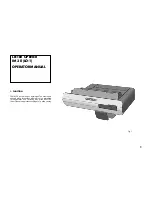
23
E N G L I S H •
User's manual
cutting bit come to a complete stop before re-
moving it from the work piece.
5. Unplug the router from the power source,
place the router upside clown on the work-
table, and inspect the finished cut in the work
piece.
WARNING: Always securely clamp the work
piece in place, and keep a firm grip on the
router base with both hands at all times. Fail-
ure to do so could result in loss of control, caus-
ing possibly serious personal injury.
WARNING: Removing the cutting bit from
work piece while it is still rotating could dam-
age the work piece and result In loss of control,
causing serious personal injury.
NOTE: Making test cuts is essential with most
routing applications. A test cut will give a feel
for the set-up, the router’s speed, the depth of
cut, and how the cutting bit reacts to the work
piece.
FREEHAND ROUTING
WARNING: Do not use large cutting bits
for freehand routing. Using large cutting bits
when freehand routing could cause loss of
control or create other hazardous conditions
that could result in personal injury. If using a
router table, large bits should be used for edg-
ing only.
When used freehand, the router becomes a
flexible and versatile tool. This flexibility makes
it possible to easily rout signs, relief sculptures, etc.
When freehand routing:
1. Draw or layout the pattern on the work
piece.
2. Choose the appropriate bit.
3. Rout the pattern in two or more passes. Do
not exceed 1/8 inch depth of cut in a single
pass. This will help provide better control, as
well as serve as a guide on the next passes.
NOTE: A core-box bit or V-groove bit is often
used tor routing letters and engraving objects.
Straight bits and ball mills are often used to
make relief carvings. Veining bits are used to
carve small, intricate details.
NOTE: Making a single, deep cut is never ad-
visable. Smaller-diameter bits are easily broken
by too much side thrust and torque. Larger bits
will cause a rough cut and be difficult to guide
and control. For these reasons, do not exceed
1/8 in. depth of cut in a single pass.
WARNING: Always securely clamp the work
piece in place, and keep a firm grip on the
router base with both hands at all times. Fail-
ure to do so could result in loss of control caus-
ing possible serious personal injury.
EDGING WITH A PILOT BIT
Arbor-type bits with pilots are excellent for
edge shaping any work piece edge that is
straight or is curved with a curvature that is
equal to or greater than the radius of the bit
that is used. The pilot prevents the bit from
making a cut that is too deep; holding the pi-
lot firmly in contact with the work piece edge
throughout the cutting process prevents the
cut from becoming too shallow.
When the
work piece
thickness and
the desired
depth of cut
are such that
only the top
part of the
edge will be
shaped, leav-
ing at least a 1/16 inch thick uncut portion be-
low, the pilot can ride against the uncut por-
tion of the work piece (Fig. 2).
If the work
piece is too
thin or the bit
is set so low so
that there will
be no uncut
edge against
which to ride
the pilot, an
extra board
must be placed under the work piece to act as
a guide (see Fig. 3).
This “guide” board must have exactly the same
shape as the work piece edge. If it is positioned
so that its edge is flush with the work piece
edge, the bit will make a full cut. If the guide
board is positioned extending beyond the
work piece edge, the bit will make less than
a full cut, altering the shape of the finished
edge.
WARNING: Always securely clamp the work
piece in place, and keep a firm grip on the
FIG. 2
Motor
housing
Spindle
Collet/Nut
Top edge of work piece
Sub-base
Pilot
Spindle lock
Cutter-
bit
TOP EDGE
SHAPING
FIG. 3
Workpiece
Guide board
Whole edge of work piece
Pilot
WHOLE EDGE
SHAPING






































